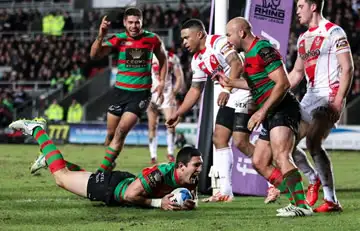World Club Series a partial success

It was unfortunate timing personally that I was out of the country for the World Club Series, and therefore not able to attend any of the games or watch them on live TV.
Instead I had to wake up on Monday morning before finding out the disappointing news that South Sydney had beaten St Helens 39-0. Despite that though, it seems the World Club Series was a partial success.
The success of the World Club Series can be measured in attendance and media coverage. The three games attracted a combined total of 51,902 people, with more than 20 thousand in attendance at Wigan for their game against Brisbane and nearly 18 thousand at Langtree Park for the main event.
There aren’t too many events in rugby league that pull in supporters in such numbers – something to bear in mind when making judgements about the series.
The same can be said for the coverage of the series – the series was a great vehicle for attracting media interest. One measure of this is that the Super League Show highlights package was broadcast nationally in the first instance, whereas, of course, the regular SLS is always first broadcast to just northern regions.
Much of this was due to the involvement of Russell Crowe, who was involved in much of the television coverage, with much made of the fact that he chose attending Saints v Souths over attending the Oscars. Crowe was able to make appearances on BBC Breakfast and Channel 4’s The Last Leg, talking up the WCC and rugby league generally, as well as his latest film.
On the pitch, however, the series was a failure. Saints’ walloping at the hands of Souths was an embarrassment. The Rabbitohs were simply a class above, especially when it came to defence. The home side put on some decent attacking plays – the kind that ripped through Salford the previous week – but they always came up second-best against a far tougher defence than they’ll likely come across in Super League.
It might be objected that the two previous games were much tighter affairs, with Warrington defeated by a mere six points and disadvantaged by the incomprehensible decision not to send off Eto Naboli for his high tackle on Kevin Penny, and Brisbane requiring extra time to beat Wigan.
However, the problem here is that Wigan and Warrington represent second and third place in last year’s Super League (based on play-off results), yet they were not playing against their opposite numbers. Brisbane Broncos finished eighth in last season’s NRL and were knocked out of the play-offs in the first round by North Queensland. St George-Illawarra finished eleventh, failing to even reach the play-offs.
That being understood, the narrow defeats do not represent even a qualified success, but rather further evidence of the NRL’s superiority.
Yet given the attendances and media coverage the World Club Series is worth persisting with. It’s future success though probably relies upon three things: having a proper series of 1st v 1st, 2nd v 2nd and 3rd v 3rd; hosting the series in Australia, or possibly a neutral location, rather than always in the UK; and Super League sides actually winning some of the games.
Good choices for Kiwi Test venues
The venues for this autumn’s England v New Zealand series were finally announced, with the opening game at Hull, the decider at Wigan, and – as had been anticipated for some time – the second Test scheduled for the Olympic Stadium.
The choice of venues seem sensibly balanced, with two games in the heartlands and one elsewhere. The Olympic Stadium is a good option – an iconic stadium of national significance, but with 54,000 seats a more realistic choice than the 90,000-capacity Wembley. Some weren’t happy about a Test match being played “down south”, but it’s worth remembering that the World Cup semi finals at Wembley attracted 67,575 people, and a Four Nations double header attracted 42,344 to the same venue in 2011.
Others weren’t happy about the omission of a West Yorkshire venue – traditionally one Test has been played at Huddersfield. However, attendances at Huddersfield tend to be lower than those at Wigan and Hull. The last Kiwi Test series in 2007 saw crowds of 20,000-plus at the latter two venues, but only 16,000 at Huddersfield. Therefore if one heartlands location is to be eliminated, it has to be Huddersfield.
Dual-reg controversy
London Broncos have signed a dual-registration agreement with Wakefield. The agreement will be of immediate a benefit to the Broncos, with Trinity’s Jarrod Sammut available to play against Leigh on Sunday. However, the agreement does present some difficulties.
For one thing, the London already have dual-registration agreements with London Skolars and Oxford. Might some Wakefield players now find themselves moving down two levels of dual-reg agreements and turning out in League One? Perhaps London will struggle to keep a settled squad if players are moving down into League One and up into Super League at points during the season. The same issues are presented by, for example, Halifax’s agreements with Newcastle and Hull KR.
Another question mark over the agreement is the possibility of London playing against Wakefield in the Qualifiers at the end of the season. Will Wakefield be happy with Sammut or anyone else playing for London against Wakefield? Would they be able to prevent it? Again, Halifax and Hull KR might run up against the same problem. There could be some controversy at the end of the season.
Keep Your Eye on Rugby League